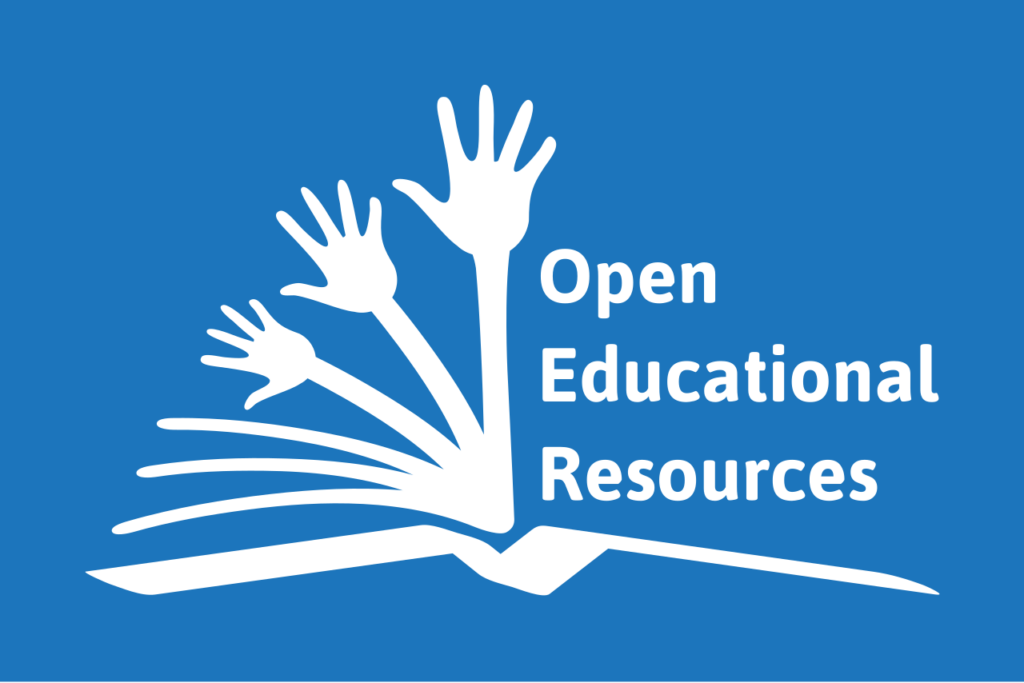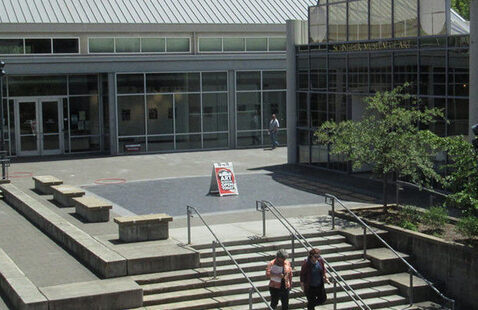The Siskiyou recently had the opportunity to speak with Open Educational Resources advocates Holly Gabriel and Professor Larry Shrewsbury about what this program has to offer at SOU. Both faculty members at the university, The Siskiyou asked what OER means to them, and how it can help SOU and its students.
Here’s what Open Access and Governmental Resources Librarian Holly Gabriel, who also leads the efforts in OER, had to say about the program:
In your own words, describe what OER does and aims to do for students at SOU.
Gabriel: Open educational resources (OER) are zero-cost or low-cost materials that are available for instructors to use and redesign for their teaching purposes. OER includes a lot of different types of materials such as textbooks, lesson plans, quiz questions, images and videos. The use of OER as course materials helps reduce the cost burden of college for students, who are often struggling to afford basic necessities such as housing and food. Research also shows that using OER improves students’ grades because students have easier access to their materials by the first day of class and are ready to learn with the course materials that they need to be successful in the class.
What OER initiatives do you anticipate will happen this upcoming Fall Term, and how will this benefit students?
Gabriel: The SOU OER Advisory Group is working on several OER initiatives. First, we will continue to advocate for quality OER materials by promoting stipends and other opportunities for instructors to learn more about open resources and/or adopt OER in their courses. These funding opportunities are from a statewide organization called Open Oregon Educational Resources, which works to make course materials more affordable and accessible for all the colleges and universities in Oregon.
Secondly, we would like to incorporate information into orientation materials for students regarding zero-cost and low-cost course material designations, so that students are aware of OER and that they know how to use the course filters in the class schedule.
Thirdly, regarding outreach, I will give updates at ASSOU, OSPIRG, and Faculty Senate meetings to share our progress. Also, during Open Education Week every year in March, we have OER exhibits in the Hannon Library and statewide webinars to raise awareness of open resources and textbook affordability issues.
On average, how many students at SOU utilize OER resources per year? Do you anticipate this number to grow?
Gabriel: I hope to have that data soon! As a result of work by the OER Advisory Group, SOU has increased our accuracy in assigning the zero-cost and low-cost attributes to courses in Banner, so that we can identify how many courses are using OER and determine how many students are enrolled in those courses. I anticipate this number to grow as more instructors see the benefits of using quality OER in their courses to improve student success. One of our goals is that by the end of Fall 2024, we want to see 25% of courses using zero-cost or low-cost course materials (for the courses which require materials).
Fortunately, we already have many classes using zero-cost and low-cost materials. For example, most of the classes for Undergraduate Studies are using zero-cost or low-cost course materials.
What has been the faculty response towards the initiative to use no-cost or low-cost teaching materials? Do you anticipate you’ll reach your Smart Goal of educating all faculty about the program by Fall Term 2022?
Gabriel: The faculty response towards using OER for teaching has been positive. SOU supports instructors’ academic freedom to choose the materials for their courses. Many faculty and whole departments consider affordability and equity when choosing their course materials. However, one challenge is that not all subject areas, especially upper-level subject areas, have quality OER available for faculty to use. Developing their own OER can be extremely time-consuming and not feasible due to all the other responsibilities faculty face in teaching, service, and scholarship. Fortunately, the amount of quality OER is growing across the world as more funding opportunities are available for faculty to create open resources and share them widely with others. I do anticipate reaching our goal of informing all faculty about OER by Fall term 2022 as we will be working closely with Department Chairs, Division Directors, Provost Walsh, and Faculty Senate to share information.
How does the library and the bookstore collaborate on this project?
Gabriel: The University Librarian and the Bookstore Director are both members of the OER Advisory Group and both have been instrumental in our textbook affordability and cost transparency initiatives. Working with our bookstore, we are now able to display the cost of course materials in the class schedule by providing a link to the bookstore’s website containing that information. Our goal is that students know these costs when they register so that they can budget accordingly. The bookstore staff and website also let students know if course materials are freely available as OER and/or if the materials are used across multiple terms. The Hannon Library is leading textbook affordability efforts by funding my position as Open Access & Government Information Librarian to champion OER initiatives on campus. The Library also manages the TextShare Program (previously funded by ASSOU), which makes some course materials available on course reserves for students to use in the library. The TextShare Program will also begin funding the purchase of library eBooks to be used for class materials, which means that students will be able to freely view their course materials online anytime.
Can anyone utilize OER, or do students have to qualify for scholarships/financial aid to be able to access the resources provided?
Gabriel: Everyone can utilize OER! OER are available to everyone because they are either materials in the public domain (not protected by copyright) or the materials have an open-license for reuse, such as a Creative Commons license, making the material freely available for others to reuse. The majority of OER are freely available online. Some students prefer print versus electronic materials, so there is often an option to print the materials.
The Siskiyou also interviewed Professor Larry Shrewsbury, who teaches several popular math courses at SOU and is a huge advocate for OER. When asked about his role in OER and the traditionally high cost of math textbooks and materials, he had this to say:
How has the math department been utilizing OER?
Shrewsbury: The math department received two grants to find suitable open-source textbooks for our MTH 243 (Intro to Statistical Methods) and MTH 111 (College Algebra). During the summer of 2016 several faculty from both SOU and Rogue Community College evaluated several open source textbooks that covered these topics. SOU found a textbook for each of these courses, where each one would be piloted by a faculty member for Fall 2016, who would then report back to the group on how well it worked out. It worked out fine for both textbooks, and we’ve been using them ever since.
How aware is the math department of OER and how they can utilize it?
Shrewsbury: They are all certainly aware that our department has been using them for several years now in our most populated math courses. And they know which faculty are using them, and that they are always welcome to ask them questions on how they too can utilize them.
Are there initiatives happening in the department towards educating faculty about OER?
Shrewsbury: No, but it’s probably not necessary. I’ve been in this department for 30 years now, and they have always been generous in sharing knowledge and information for teaching their classes. If any of us want to know anything about teaching a class, all we have to do is ask another faculty in our department about the resources they used and it has always been shared freely.
How much do upper division math courses usually cost for students? What about lower division courses?
Shrewsbury: I’m not as familiar with the upper division since I don’t teach those, but looking on the bookstore website I’m seeing $286 for a new Calculus textbook, and $141 for a used one. For our most heavily populated course, MTH 243, students used to pay $237 for a new textbook, or $178 for a used one. That was back in 2016, but for several years now students download a free pdf file of their textbook, or if they wish, they can get a hard copy for about $25. And for our MTH 111/112 courses, students used to pay $313 for a new textbook, or $235 for a used one. That too is now a free pdf file, or optional hard copy if they wish to have one ($40).
Could there be a future where SOU’s math classes are completely no cost/low cost?
Shrewsbury: That probability will continue to rise as more high-quality open-source textbooks become available. They are harder to find for the upper division courses.
Lastly, The Siskiyou was curious about what lights their fire in advocating for more affordable courses, and why the program’s growth is so important to them.
What made you decide to involve yourself in OER, and what keeps you passionate about the program?
Gabriel: I remember the high cost of textbooks as a college student myself, and I want to help reduce this struggle for students. Nobody should have to decide between buying food or buying their textbooks. I’m so appreciative of the members of our OER Advisory Group – Dale Vidmar, Rebekah Kenney, Winter Woods, Adam Corman, Larry Shrewsbury, John Taylor, and David Pouliot – for their energy and guidance on this collaborative work. Positive feedback and appreciation from students also keeps me passionate about our campus OER initiatives!
Shrewsbury: I was invited to join back in June 2021 when it was just getting started. I agreed to join since I was very familiar with the topic: I had submitted the grant for the MTH 243 textbook search, I had been using an open-source textbook for several years, and I had given a presentation on it at the 2017 Open Education Symposium. So, I was a prime candidate to be on the team. The free open-source textbooks have resolved TWO big issues: for the students it saved them from a significant expense; for me the instructor, I don’t have students struggling in the course due to not having the textbook (now they may struggle due to OTHER reasons, but not because of a lack of a textbook).
Holly Gabriel also provided The Siskiyou with an example of how students can filter their course searches to show them which classes utilize OER, a wonderful option for any and all students looking to save money and give them the best chances possible to succeed in their academic career.




